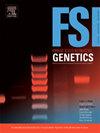Developmental validation of a multiplex qPCR assay for simultaneous quantification of nuclear and mitochondrial DNA
IF 3.2
2区 医学
Q2 GENETICS & HEREDITY
引用次数: 0
Abstract
Quantification of human DNA is key in forensic genetics. A more accurate estimate of the amount of DNA is essential for planning and optimising genotyping assays, as is evaluating the presence of PCR inhibitory substances and DNA degradation status. Multiplex qPCR assays are helpful in forensics because they can quantify different targets simultaneously, thus saving valuable samples, time, and labour. The aim of this study was to highlight the challenges in the developmental validation of a multiplex real-time PCR assay and the drawbacks encountered in translating a previously described and validated assay (SD quants) to a different technology by modifying the dye probes and reagent mix to be used in a different instrument. We developed a TaqMan probe-based multiplex qPCR using reagents and fluorescent probes adapted for the Rotor-Gene 6000 instrument (QIAGEN, Hilden, Germany). The initial assay combined two mitochondrial DNA (mtDNA) and two nuclear DNA (nDNA) targets, with amplification products of different sizes (mtDNA = 69 and 143 bp; nDNA = 71 and 181 bp), to estimate the DNA degradation status and an internal positive control (IPC) to detect potential inhibitors. During the initial testing of the assay, we observed an interaction between the 69 bp mtDNA target and the 71 bp nDNA target probe, and experiments were conducted to resolve this issue without success. We removed the small nDNA target (71 bp) and changed from a 5-plex to a 4-plex qPCR assay (qMIND). The final tetraplex assay was tested on 105 forensic samples and/or small amounts of degraded DNA, such as bones, teeth, fingernails, formalin-fixed paraffin-embedded tissues (FFPE), and hair shaft samples. The quantification results were compared with data acquired from the same samples using another commercially available quantification system commonly used in forensic laboratories. In addition, the short tandem repeat (STR) profiles were investigated to determine their correlation with the quantitative values obtained. Overall, the qPCR assay was robust and reliable for DNA quantification in samples commonly used in forensic practice.
用于同时定量核DNA和线粒体DNA的多重qPCR测定的开发验证。
人类 DNA 的定量是法医遗传学的关键。更准确地估计 DNA 的数量对于规划和优化基因分型测定以及评估 PCR 抑制物质的存在和 DNA 降解状况至关重要。多重 qPCR 检测可同时量化不同的目标,从而节省宝贵的样本、时间和劳动力,因此对法医工作很有帮助。本研究旨在强调多重实时 PCR 检测开发验证过程中的挑战,以及通过修改染料探针和试剂混合液以用于不同仪器,从而将先前描述和验证过的检测方法(SD quants)转化为不同技术时遇到的弊端。我们开发了一种基于 TaqMan 探针的多重 qPCR,使用的试剂和荧光探针适用于 Rotor-Gene 6000 仪器(QIAGEN,德国希尔登)。最初的检测结合了两个线粒体 DNA (mtDNA) 和两个核 DNA (nDNA) 靶标,扩增产物的大小不同(mtDNA = 69 和 143 bp;nDNA = 71 和 181 bp),以估计 DNA 降解状况,并使用内部阳性对照 (IPC) 检测潜在的抑制剂。在化验的初始测试中,我们观察到 69 bp mtDNA 靶标和 71 bp nDNA 靶标探针之间存在相互作用,为了解决这个问题,我们进行了实验,但没有成功。我们移除了小的 nDNA 靶标(71 bp),并将五重 qPCR 检测改为四重 qPCR 检测(qMIND)。我们在 105 份法医样本和/或少量降解 DNA(如骨头、牙齿、指甲、福尔马林固定的石蜡包埋组织 (FFPE) 和毛发样本)上测试了最终的四重检测方法。定量结果与使用法医实验室常用的另一种市售定量系统从相同样本中获得的数据进行了比较。此外,还对短串联重复(STR)图谱进行了调查,以确定其与定量值之间的相关性。总体而言,qPCR 分析法在法医实践中常用样本的 DNA 定量方面是稳健可靠的。
本文章由计算机程序翻译,如有差异,请以英文原文为准。
求助全文
约1分钟内获得全文
求助全文
来源期刊
CiteScore
7.50
自引率
32.30%
发文量
132
审稿时长
11.3 weeks
期刊介绍:
Forensic Science International: Genetics is the premier journal in the field of Forensic Genetics. This branch of Forensic Science can be defined as the application of genetics to human and non-human material (in the sense of a science with the purpose of studying inherited characteristics for the analysis of inter- and intra-specific variations in populations) for the resolution of legal conflicts.
The scope of the journal includes:
Forensic applications of human polymorphism.
Testing of paternity and other family relationships, immigration cases, typing of biological stains and tissues from criminal casework, identification of human remains by DNA testing methodologies.
Description of human polymorphisms of forensic interest, with special interest in DNA polymorphisms.
Autosomal DNA polymorphisms, mini- and microsatellites (or short tandem repeats, STRs), single nucleotide polymorphisms (SNPs), X and Y chromosome polymorphisms, mtDNA polymorphisms, and any other type of DNA variation with potential forensic applications.
Non-human DNA polymorphisms for crime scene investigation.
Population genetics of human polymorphisms of forensic interest.
Population data, especially from DNA polymorphisms of interest for the solution of forensic problems.
DNA typing methodologies and strategies.
Biostatistical methods in forensic genetics.
Evaluation of DNA evidence in forensic problems (such as paternity or immigration cases, criminal casework, identification), classical and new statistical approaches.
Standards in forensic genetics.
Recommendations of regulatory bodies concerning methods, markers, interpretation or strategies or proposals for procedural or technical standards.
Quality control.
Quality control and quality assurance strategies, proficiency testing for DNA typing methodologies.
Criminal DNA databases.
Technical, legal and statistical issues.
General ethical and legal issues related to forensic genetics.

 求助内容:
求助内容: 应助结果提醒方式:
应助结果提醒方式:


